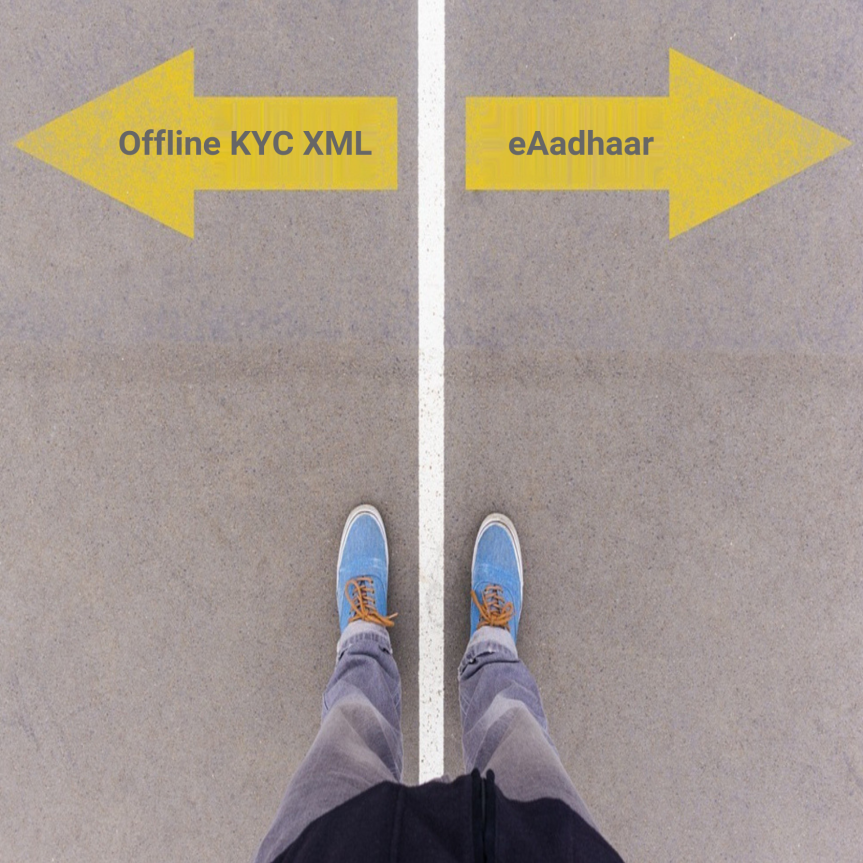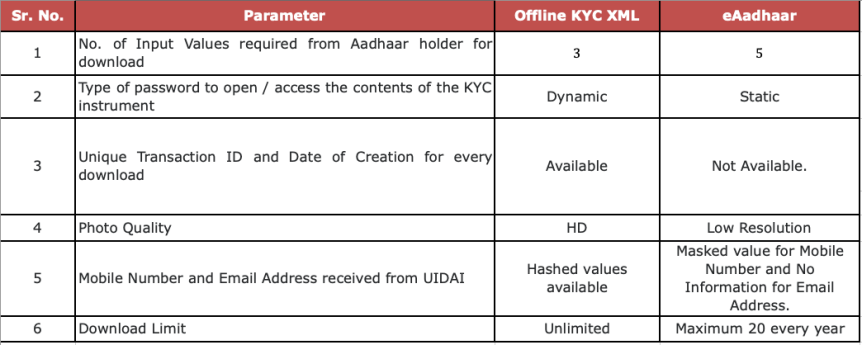
As seen in our earlier blog posts on Aadhaar-based Offline KYC (here and here), most of you must be aware that UIDAI supports the initiation and completion of Offline KYC transactions through two instruments – eAadhaar and Offline KYC XML.
While enterprises can choose any of these two instruments to initiate and complete Offline KYC transactions, our experience has shown that Offline KYC XML offers more advantages than eAadhaar.
Below are a few reasons why we recommend Offline KYC XML over eAadhaar:
1. Convenience
To download his/her Offline KYC document from UIDAI’s website for validation, an Aadhaar holder has to input only 3 values:
- Aadhaar Number/VID
- Captcha value, and
- OTP value
Whereas, to download his/her eAadhaar from UIDAI’s website, an Aadhaar holder has to input 5 values:
- Aadhaar Number/VID
- Full Name as registered with Aadhaar
- Residential Pin Code as registered with Aadhaar
- Captcha value, and
- OTP value
We have witnessed that many times, Aadhaar holders are unable to recollect their exact Full Name (as registered with Aadhaar) which leads to multiple attempts to download their eAadhaar resulting in 30-40 seconds longer time in completing the Offline KYC transaction as compared to the one using their Offline KYC XML document.
2. Security
To open or access an eAadhaar file, only a static password is needed (first 4 letters of the Aadhaar holder’s name – in Upper Case, followed by his/her year of birth – in YYYY format). Whereas, when downloading the Offline KYC XML document, an Aadhaar holder is given the option of creating a dynamic 4-digit password for every Offline KYC XML document that is being downloaded.
The usage of a dynamic password for every Offline KYC XML document ensures that the user gets a higher degree of control to encrypt his/her KYC data.
3. Traceability
Every time an Offline KYC XML file is downloaded, a unique ‘Transaction ID’ is automatically generated by UIDAI. However, in the case of eAadhaar, no Transaction ID gets automatically generated.
Further, the response file of every Offline KYC XML file includes a ‘Date of Creation’ that is conspicuously missing in an eAadhaar file.
4. Photo Quality
In most cases, an Aadhaar holder’s photograph that is embedded in the QR Code of his/her eAadhaar file is of very poor quality (resolution) which makes it difficult to read by machines as well as humans. Whereas, a High Definition (HD) photograph can be easily retrieved from an Aadhaar holder’s Offline KYC XML file.
Photo quality is a critical factor as it plays a pivotal role in Face Authentication.
5. Mobile Number and Email Address Validation
Since every Offline KYC XML file contains the hashed value of an Aadhaar holder’s Mobile Number and Email Address (that is registered with Aadhaar), enterprises can easily validate them with UIDAI by following three easy steps:
- Capturing the Mobile Number and/or Email Address from the Aadhaar holder
- Generating their respective hash values by using UIDAI’s Hash Generator, and
- Comparing them with the Mobile Number and Email Address’s original hash values (that are present in the Offline KYC XML file) for validation.
This is not possible in the case of eAadhaar as the QR Code in an eAadhaar file contains only the masked value of the Aadhaar holder’s Mobile Number and no information whatsoever about his/her Email Address.
6. Download Limit
An Offline KYC XML file can be downloaded by an Aadhaar holder as many times as s/he wants. But this is not the case with eAadhaar. As on date, an Aadhaar holder can download his/her eAadhaar file maximum 20 times a year, not more than that.
Here is a quick summary of the comparison between Offline KYC XML and eAadhaar:

Feel free to get in touch with our colleague Amit Joshi on 9820875525 or 7208155528, or email him on amit@eastcs.com if you have any queries, or need any more information.
–
Regards
Team ECS.
